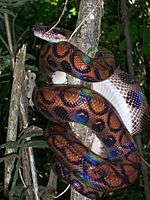Rainbow boa facts for kids
Quick facts for kids Rainbow boa |
|
|---|---|
 |
|
| Conservation status | |
| Scientific classification | |
| Genus: |
Epicrates
|
| Species: |
cenchria
|
| Synonyms | |
|
Synonyms List
|
|
The rainbow boa (Epicrates cenchria) is a boa species endemic to Central and South America. A semi-arboreal species (not only do they climb in they wild but also proven in captivity), it is known for its attractive iridescent/holographic sheen caused by structural coloration. Five subspecies are currently recognized, including the nominate subspecies described here.
Contents
Distribution and habitat
The rainbow boa is found in lower Central America (Costa Rica and Panama), and farther south into South America. It occurs east of the Andes, roughly reaching northern Argentina (in the provinces Chaco, Córdoba, Corrientes, Formosa, Salta, Santiago del Estero and Tucumán).
The rainbow boa's habitat generally consists of humid woodlands and rainforests, but it can also be found in open savannas.
Behavior
Rainbow boas are nocturnal and most active in the middle of the night.
This species is semi-arboreal, spending time both on the ground and in trees. They are also known to spend time in bodies of water, and are considered capable swimmers.
Mating Habits
Rainbow boa sexes have different ages at which they can/should mate. Females should be from 2.5 to 4.5 years old before breeding. Males should be a minimum of 2.5 years old. Females need to be the correct size otherwise they could have complications during and after birth. Males can mate with multiple females which can be beneficial for reptile breeding.
Eating Habits During Breeding Season
Males generally go without feeding during the mating season and Females tend to eat smaller portions during the breeding season. In order to decrease the probability of birthing issues, Females should be fed smaller rats/mice in order to save space for proper ova development.
It is not unusual for both sexes to go without eating during the mating season.
Captivity
The most common type of rainbow boa found in the pet trade is the Brazilian rainbow boa, E. c. cenchria. During the 1980s and early 1990s, substantial numbers were exported from Suriname. Today, however, far fewer are exported, and most offered for sale are captive bred. With good care, a captive Brazilian rainbow boa can be expected to live for up to 30 years.
Subspecies
| Subspecies | Taxon author | Common name | Geographic range |
|---|---|---|---|
| Epicrates cenchria barbouri | Stull, 1938 | Marajo Island rainbow boa | |
| Epicrates cenchria cenchria | (Linnaeus, 1758) | Brazilian rainbow boa | the Amazon Basin and in coastal Guiana, French Guiana, Suriname and southern Venezuela |
| Epicrates cenchria gaigeae | Stull, 1938 | Peruvian rainbow boa | |
| Epicrates cenchria hygrophilus | Amaral, 1935 | Espirito Santo rainbow boa | |
| Epicrates cenchria polylepis | Amaral, 1935 | Central Highlands rainbow boa |
Etymology
The subspecific names barbouri and gaigeae are in honor of American herpetologists Thomas Barbour and Helen Beulah Thompson Gaige, respectively.
Fascinating Appearance:
Rainbow Boas are renowned for their fascinating appearance, which captivates reptile enthusiasts and nature lovers alike. Their striking features contribute to their allure and make them stand out among other snake species.
Vibrant Colors:
One of the most captivating aspects of Rainbow Boas is their vibrant and iridescent colors. They possess a wide range of hues, including deep reds, oranges, yellows, greens, blues, and even purples. The iridescence of their scales gives them a mesmerizing shimmer when light reflects off them. These vivid colors make Rainbow Boas visually stunning and eye-catching creatures.
Unique Patterns:
In addition to their vibrant colors, Rainbow Boas display unique patterns on their scales. These patterns can vary from species to species and even among individuals. Some Rainbow Boas have distinct saddle-shaped markings along their bodies, while others may exhibit blotches or speckles. These patterns add to their visual appeal and make each snake distinct and visually captivating.
Scales:
Rainbow Boas have smooth and glossy scales that contribute to their overall aesthetic appeal. The scales are not only visually pleasing but also serve functional purposes. The overlapping scales provide protection, minimize water loss, and aid in their movement through various terrains. The sleekness of their scales enhances the overall beauty of Rainbow Boas.
The combination of vibrant colors, unique patterns, and smooth scales makes Rainbow Boas truly remarkable in terms of their appearance. Their visual allure is often a primary reason why they are admired and sought after as both exotic pets and subjects of fascination in the natural world.
In the next section, we will explore the behavioral characteristics and natural habitat of Rainbow Boas, shedding light on their intriguing behavior and ecological significance.
Gallery
See also
 In Spanish: Boa arco iris para niños
In Spanish: Boa arco iris para niños



